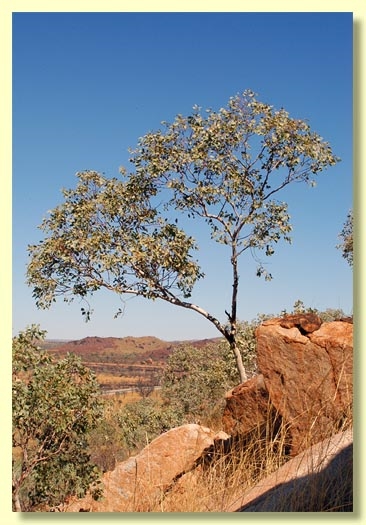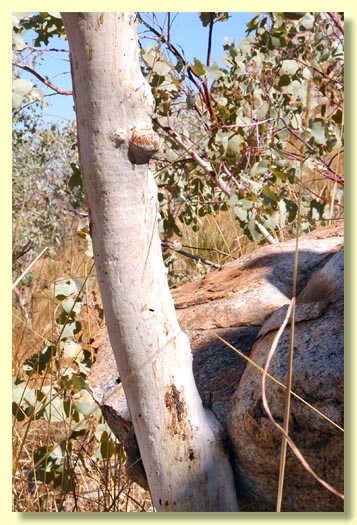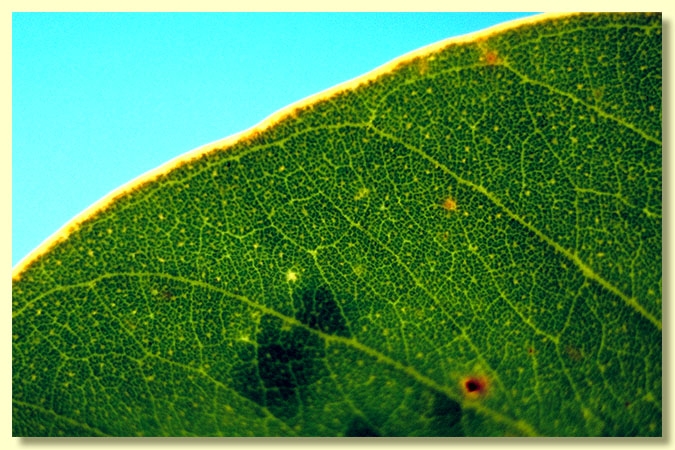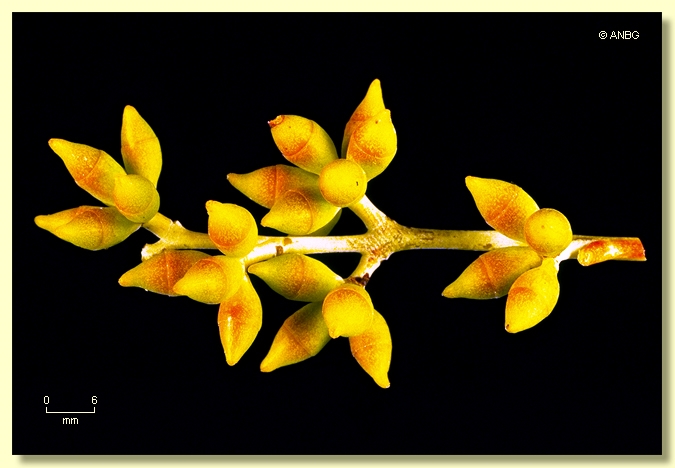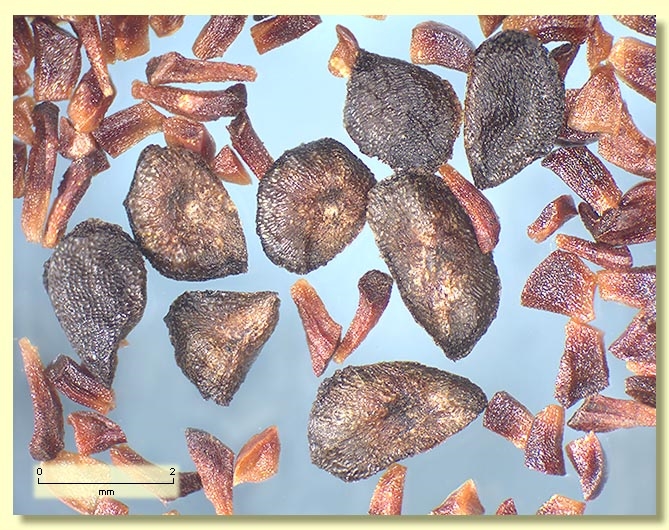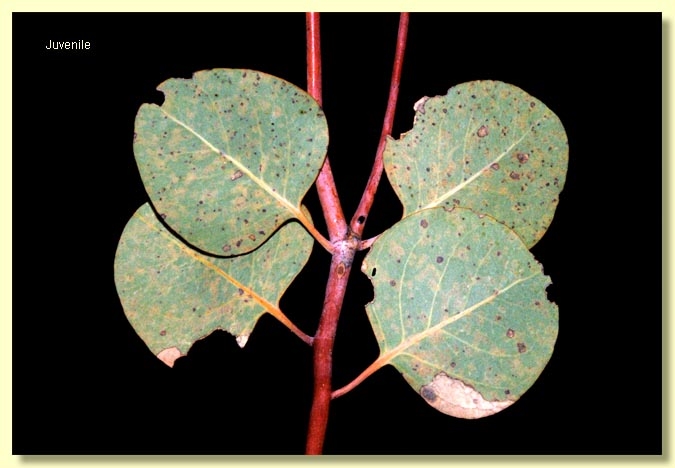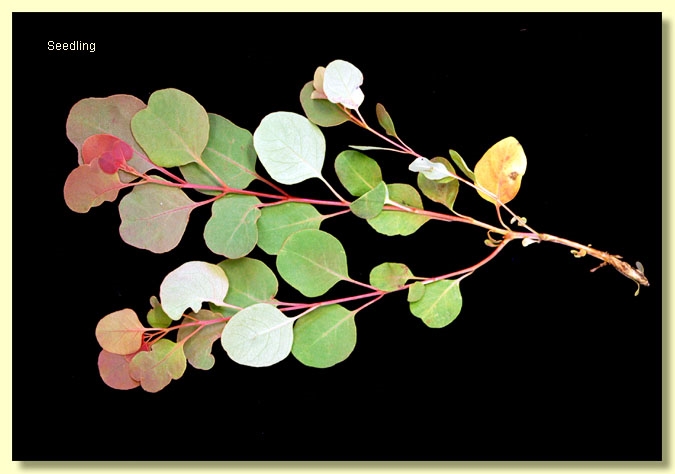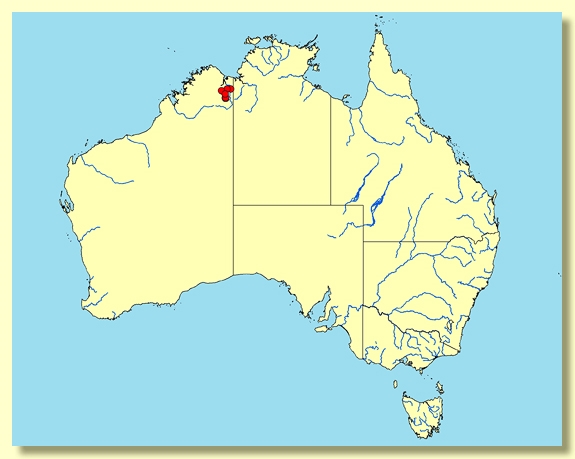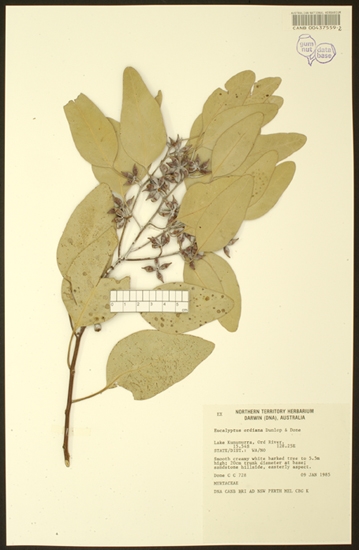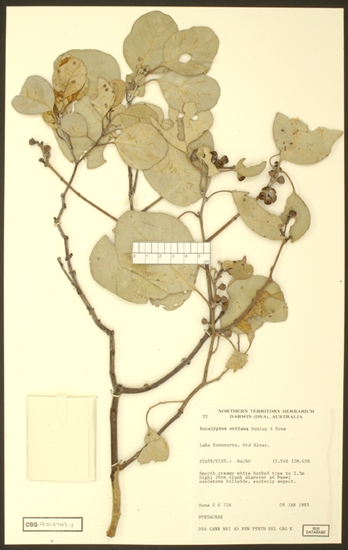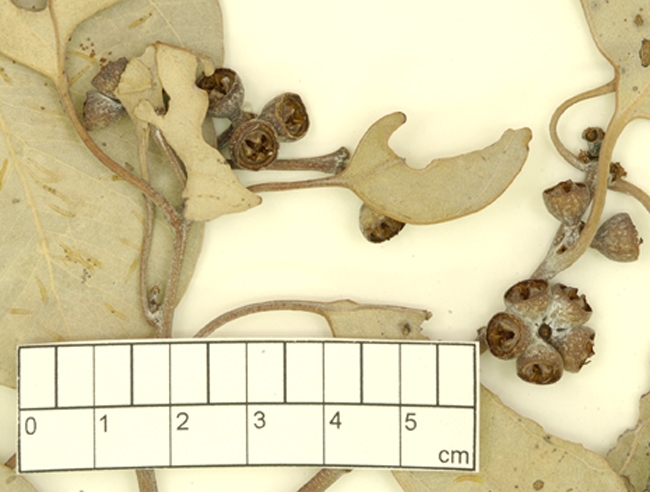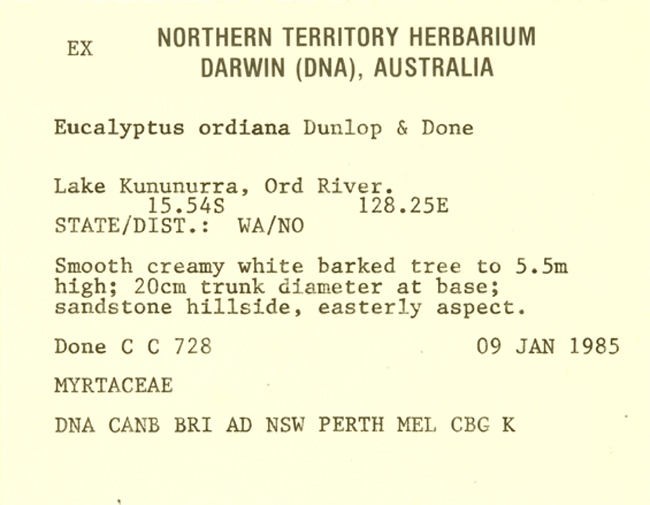Eucalyptus | Symphyomyrtus | Platysperma
Euclid - Online edition
Eucalyptus ordiana
Eucalyptus ordiana Dunlop & Done, Nuytsia 8 (2) 195 (1992).
T: Lake Kununurra, Ord River, 15° 54’S, 128° 45’E, C.Done 728, 9 January, 1985; holo: PERTH; iso: AD, BRI, CANB, DNA, K, MEL, NSW.
Tree or mallee to 6 m tall. Forming a lignotuber.
Bark smooth throughout, powdery white, weathering in patches to purple.
Juvenile growth (coppice or field seedlings to 50 cm): stems square to rounded in cross-section, glaucous; juvenile leaves always petiolate, opposite to alternate, orbicular, 4–8 cm long, 4.5–10 cm wide, base rounded to truncate, apex rounded, blue-grey to glaucous or weathering to green.
Adult leaves alternate to sub-opposite, petioles 1.2–3 cm long; blade ovate to rarely broadly lanceolate, (3.5)6–9 cm long, 2–8 cm wide, base truncate to rounded to rarely tapering to petiole, margin entire, apex pointed, concolorous, dull and glaucous but weathering to grey-green, side-veins at a wider angle than 45° to the midrib, reticulation dense to very dense, intramarginal vein often looped well inside the leaf margin, oil glands obscure.
Inflorescence axillary unbranched, peduncles 0.3–0.8(1) cm long, buds 7 per umbel, sessile to shortly pedicellate (pedicels 0–0.2 cm long). Mature buds glaucous, ovoid, 0.7–1 cm long, 0.4–0.6 cm wide, scar present, operculum conical to beaked (0.4–0.6 cm long), irregularly inflexed, anthers oblong, versatile, dorsifixed, dehiscing by longitudinal slits, style long and straight, stigma blunt to tapered, locules 3(4), the placentae each with 6 or more vertical rows of ovules. Flowers white.
Fruit sessile to shortly pedicellate (pedicels 0–0.3 cm long), cup-shaped to rarely hemispherical, glaucous, 0.4–0.8 cm long, 0.5–0.7(0.9) cm wide, disc raised, valves 3(4), at rim level or exserted.
Seeds brown to yellowy brown, 1–1.5 mm long, flattened-ovoid, dorsal surface shallowly reticulate, edge of seed smooth, hilum ventral.
Cultivated seedlings (measured at ca node 10): cotyledons oblong; stems square in cross-section, smooth, non-glaucous; leaves always petiolate (petioles 1–1.5 cm long), opposite for 12+ pairs or becoming sub-opposite to alternate after ca 7 pairs sometimes reverting to opposite, ± orbicular, 3–4 cm long, 2.8–4 cm wide, base truncate to broadly tapering, margin entire, apex rounded, slightly glossy, green, discolorous.
Flowering has been recorded in April and July.
A small tree or mallee endemic to the eastern Kimberley region of Western Australia, from rocky hillsides in the Turkey Creek, Kununurra area. Characterised by the smooth powdery white bark, broad, petiolate, ovate, glaucous leaves of the mature crown, glaucous buds with a conical to beaked operculum and glaucous fruit with a relatively narrow slightly ascending disc.
Eucalyptus ordiana belongs in a group of species that are distinguished by having smooth bark, very dense reticulation in the adult leaves and flat, flattened-ovoid, non-toothed, pale yellow-brown to brown seeds with a ventral hilum. The other members of this group are E. kenneallyi, E. umbrawarrensis, E. rupestris, E. confluens, E. brevifolia and E. leucophloia.
Within this group, E. ordiana is distinguished from E. brevifolia and E. confluens by the narrow disc of the fruit. Both E. brevifolia and E. confluens have fruit with a broad flat to slightly ascending disc. E. confluens, along with E. umbrawarrensis, is further distinguished by having glossy, lanceolate adult leaves. (E. ordiana is dull leaved and ovate to sometimes broadly lanceolate.) E. leucophloia can be separated by its operculum shape (rounded to bluntly conical in E. leucophloia and acutely conical to beaked in E. ordiana). E. rupestris and E. kenneallyi differ by having smaller leaves in the mature crown and narrower fruit (E. rupestris and E. kenneallyi with leaves usually narrower than 2.5 cm and fruit narrower than 0.4 cm, E. ordiana with mature crown leaves usually wider than 2.5 cm and fruit wider than 0.5 cm).
Within its area of occurrence, E. ordiana maybe confused with other closely related white gums, particularly those with broad adult leaves (i.e. E. alba var. australasica, E. apodophylla, E. mooreana and E. pantoleuca) and to a lesser extent, those with much narrower adult leaves (i.e. E. cupularis, E. gregoriensis, E. herbertiana and E. houseana).
Eucalyptus alba var. australasica differs by having non-glaucous buds and fruit (usually very glaucous in E. ordiana). E. apodophylla and E. mooreana are distinguished by having sessile, opposite leaves in the mature crown (always petiolate and normally sub-opposite to alternate in E. ordiana). E. pantoleuca is easily distinguished by its very large buds which are in groups of three per umbel (E. ordiana seven-budded).
E. cupularis, E. gregoriensis, E. herbertiana and E. houseana can all be easily distinguished by their relatively long lanceolate adult leaves (E. ordiana normally with ovate adult leaves no longer than 9 cm and all the others with adult leaves normally longer than 9 cm). E. gregoriensis can be further distinguished by having three-budded umbels (always seven-budded in E. ordiana), and E. herbertiana is normally not glaucous in the buds and fruit (E. ordiana always with glaucous buds and fruit).
Eucalyptus ordiana: from the locality, the Ord River.

